If you’ve noticed your plants stretching toward the light with long, spindly stems and sparse foliage, you’re dealing with a common condition called legginess. While it might look concerning, you can transform your lanky plants into fuller, healthier specimens through strategic pruning and environmental adjustments. The key lies in understanding why your plants are reaching for the sky and taking specific steps to correct their growing conditions.
Contents
- 1 Prune Stems Above Leaf Nodes
- 2 Move Closer to Light
- 3 Rotate Pots Weekly
- 4 Provide Appropriate Plant Support
- 5 Control Indoor Temperature Range
- 6 Adjust Fertilizer Application Schedule
- 7 Thin Overcrowded Plants Regularly
- 8 Reduce Stem Watering Frequency
- 9 Transplant to Bigger Containers
- 10 Strengthen Stems With Airflow
Prune Stems Above Leaf Nodes

Snip your leggy plants back to health by pruning stems just above the leaf nodes, where new growth emerges. Using clean, sharp pruning shears, make 45-degree angle cuts roughly 1/4 inch above each node to encourage healthy branching and prevent disease.
You’ll want to identify the strongest leaf nodes before making any cuts. Look for small bumps or ridges along the stem where leaves attach, as these spots contain dormant buds that’ll sprout new growth. If you’re working with severely leggy plants, don’t remove more than 1/3 of the total growth at once.
After pruning, you’ll notice new shoots developing within 1-2 weeks. Remember to save your healthiest cuttings – you can propagate them in water or moist soil to create new plants while you’re fixing the leggy ones.
Move Closer to Light
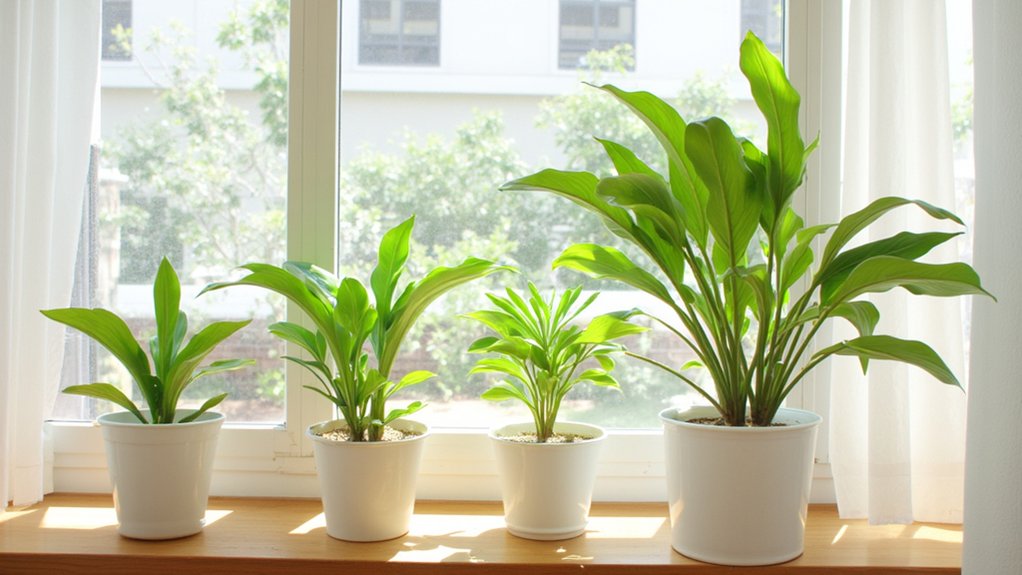
Since inadequate light is often the main culprit behind leggy growth, you’ll need to relocate your plants to a brighter spot for best results. Choose a location within 6-12 inches of a south or west-facing window, where your plants can receive 6-8 hours of bright, indirect sunlight daily.
If you’re using artificial grow lights, position them 4-6 inches above your plants’ canopy, adjusting the height as they grow. For ideal results, keep the lights on for 12-16 hours per day, depending on your plants’ specific needs.
Monitor your plants’ response to their new lighting conditions over the next 7-10 days. You’ll notice new growth becoming more compact and sturdy, while leaves may develop deeper coloration. If leaves show signs of burning, increase the distance from the light source by 2-3 inches.
Rotate Pots Weekly
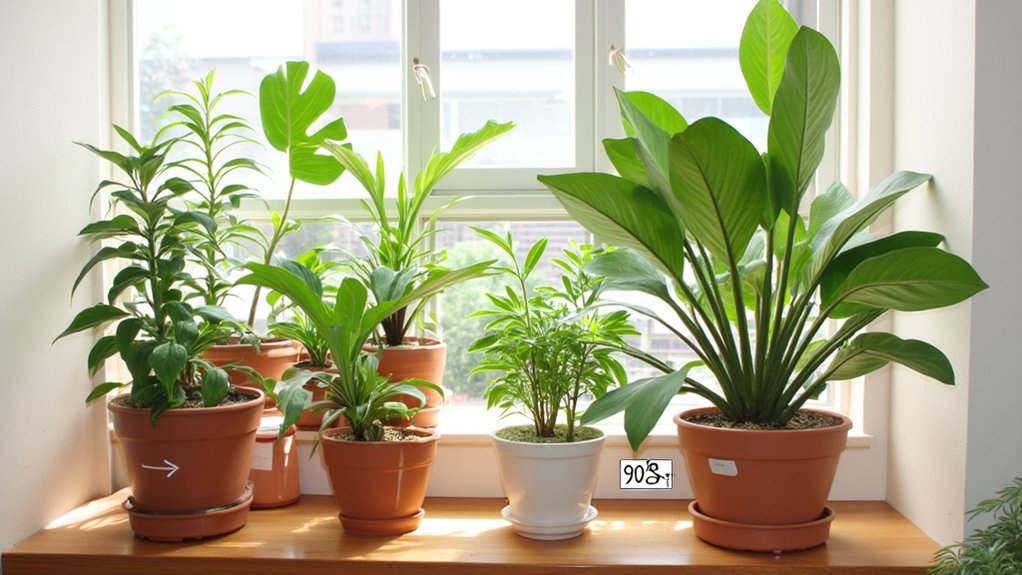
Regular rotation of your potted plants is essential for preventing uneven, leggy growth. Each week, turn your containers approximately 90 degrees clockwise, ensuring all sides receive equal light exposure throughout the month.
You’ll notice that plants naturally grow toward light sources, so without rotation, they’ll develop a lopsided appearance. Set a specific day for rotating – perhaps Sunday morning – and mark the pot’s original position with a small arrow to track your turns accurately.
For larger plants that are difficult to move, consider using a rolling plant stand. If you’re dealing with multiple plants, create a rotation schedule and stick it near your watering calendar. After about three weeks of consistent rotation, you’ll see more balanced, compact growth patterns emerging.
Provide Appropriate Plant Support
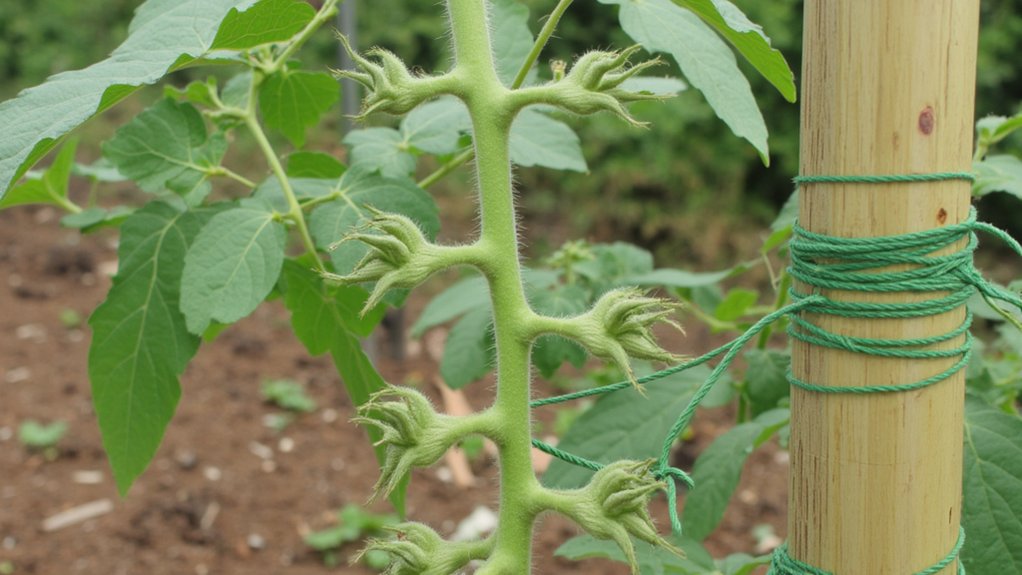
Supporting leggy plants goes hand-in-hand with proper rotation to encourage strong, upright growth. You’ll need to select supports that match your plant’s size and growing pattern, whether that’s bamboo stakes, trellises, or metal cages.
For tall, single-stemmed plants, insert a stake about 1-2 inches from the main stem, ensuring it’s deep enough to provide stability. Use soft plant ties or twine to secure the stem every 6-8 inches, creating a figure-eight pattern that won’t damage the plant.
If you’re dealing with vining plants, install a trellis or cage when the plant is young. Position it at a 15-degree angle away from the wall to maximize light exposure and air circulation. Remember to check and adjust ties weekly as your plant grows.
Control Indoor Temperature Range
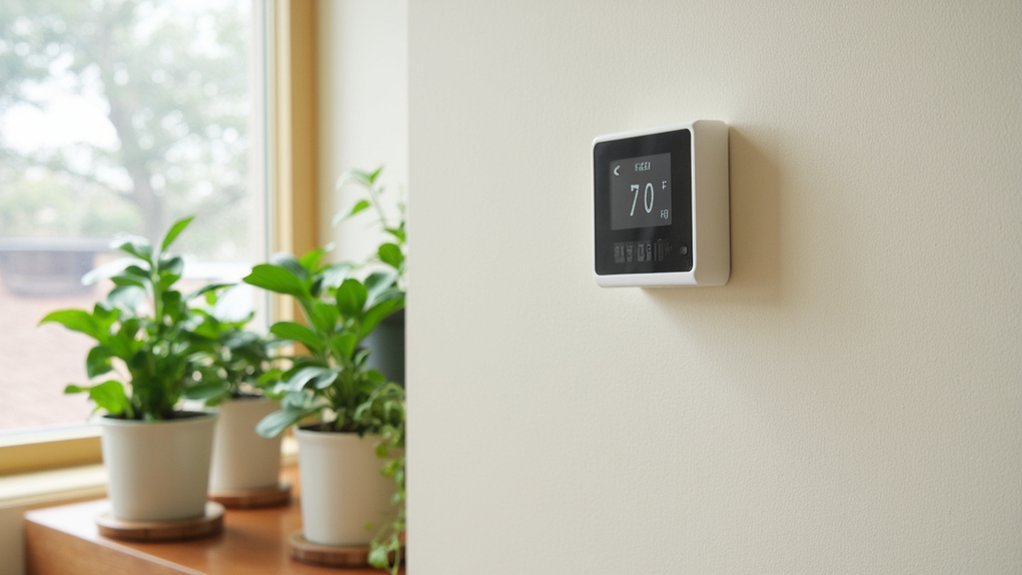
Although many gardeners focus on light and water, maintaining the right temperature range is essential for preventing leggy growth in indoor plants. Most houseplants thrive between 65-75°F during the day and about 10 degrees cooler at night, which helps maintain compact growth patterns.
Keep your plants away from drafty windows and heating vents, as temperature fluctuations can stress plants and trigger leggy growth. If you’re using grow lights, make sure they aren’t generating excess heat that could raise temperatures above ideal levels.
Monitor your room temperature with a reliable thermometer, and consider using a smart thermostat to maintain consistent temperatures. During summer months, you’ll want to adjust your air conditioning settings to prevent temperatures from climbing above 80°F, which can cause plants to stretch while seeking cooler air.
Adjust Fertilizer Application Schedule
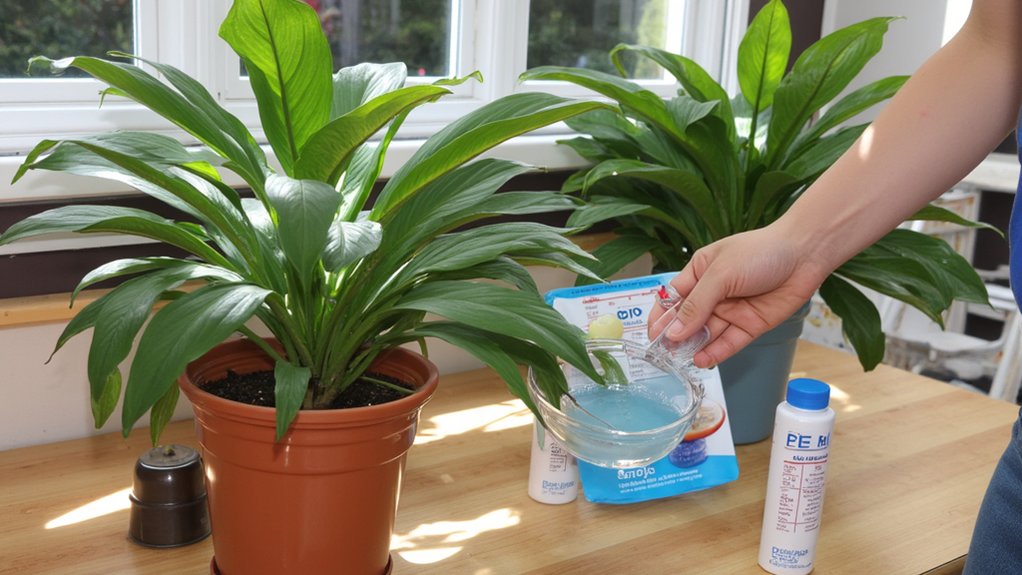
Proper fertilization goes hand-in-hand with temperature control when preventing leggy growth in indoor plants. You’ll need to reduce fertilizer application during fall and winter months, when most plants naturally slow their growth cycle.
During the growing season, fertilize your plants every 4-6 weeks with a balanced, water-soluble fertilizer at half-strength. If you’re using a 10-10-10 formula, dilute it to 5-5-5 to avoid overstimulating vertical growth.
Watch for signs of over-fertilization, such as yellow leaf tips or rapid, weak stem growth. If you notice these symptoms, flush the soil thoroughly with plain water and wait 8-10 weeks before resuming fertilization. Remember, it’s better to under-fertilize than to overfeed your plants, especially when combating legginess.
Thin Overcrowded Plants Regularly
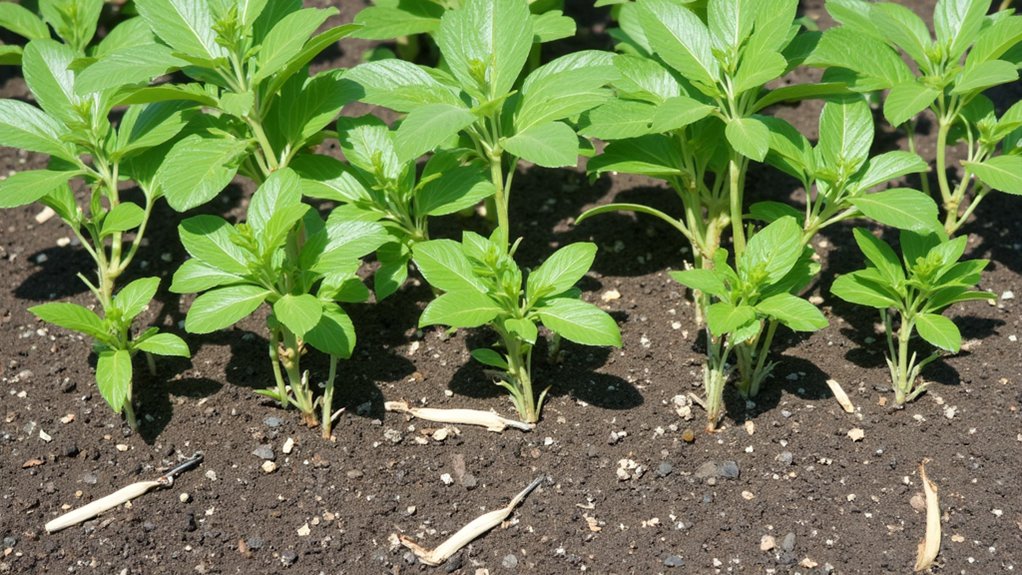
Crowded plants compete intensely for light, leading to stretched stems and sparse foliage as they reach toward limited sunshine. To prevent this, you’ll need to thin your plants when they’re young, typically when they’ve grown their first set of true leaves.
Start by identifying the strongest seedlings, which usually have thick stems and vibrant leaves. Using clean scissors or pruning shears, snip off weaker plants at soil level, leaving 2-3 inches of space between remaining specimens. For larger plants, maintain distances of 6-12 inches, depending on their mature size.
Don’t pull plants out by their roots, as this can disturb neighboring plants’ root systems. If you’re growing vegetables, save your thinned seedlings – they’re perfect additions to salads and microgreen dishes.
Reduce Stem Watering Frequency
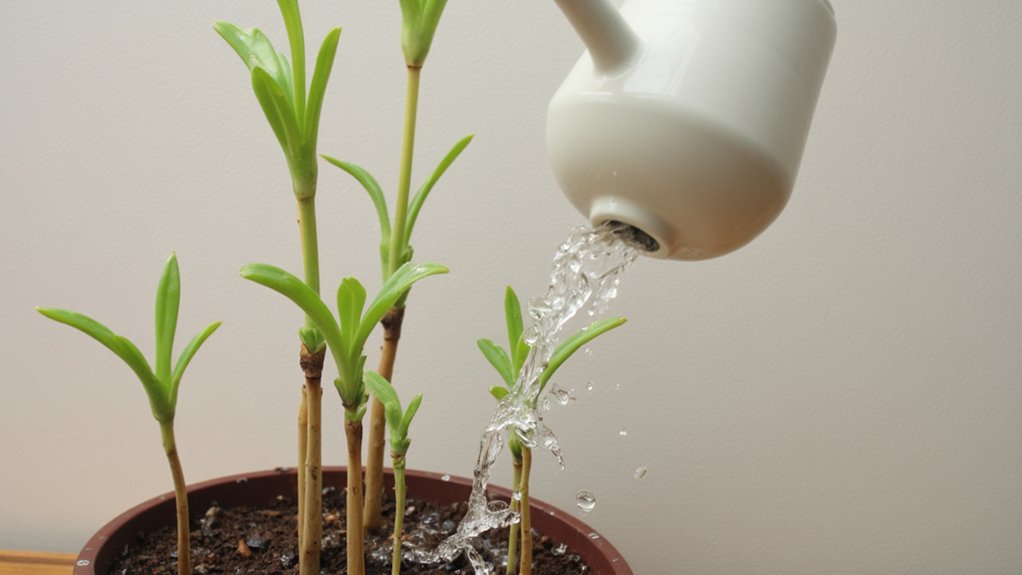
When you water leggy plants directly on their stems, you’re encouraging weak, elongated growth that makes the problem worse. Instead, direct water at the soil level, keeping the plant’s base and stems relatively dry to promote stronger growth patterns.
Create a consistent watering schedule that allows the top 1-2 inches of soil to dry between sessions. For most indoor plants, this means watering every 7-10 days, though you’ll need to adjust based on your specific plant variety and environment. Use your finger to test soil moisture before watering.
If you’re using a spray bottle for humidity, aim the mist toward the leaves rather than the stems. This technique helps maintain necessary moisture levels while discouraging the leggy growth that often results from stem-focused watering patterns.
Transplant to Bigger Containers
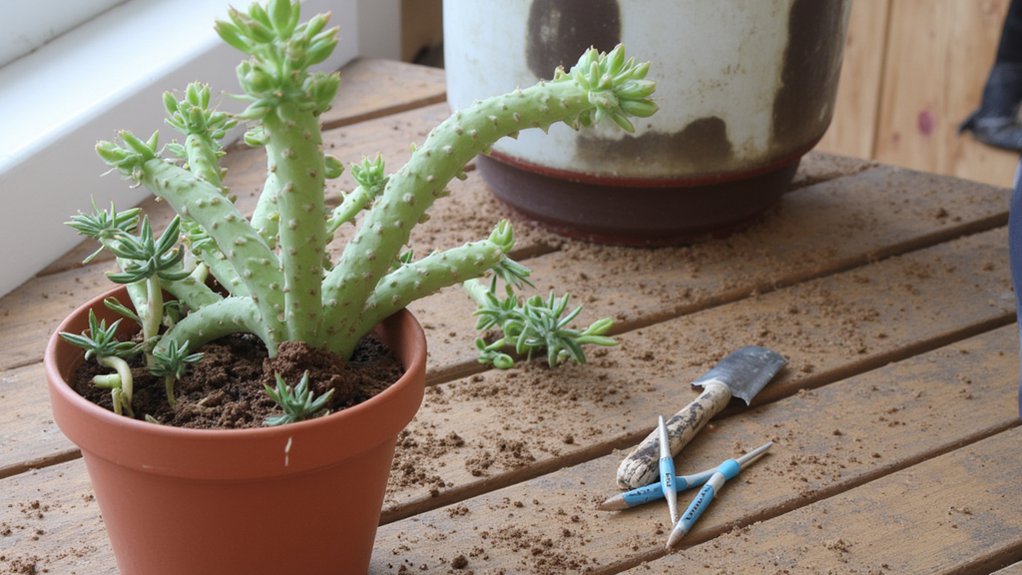
Leggy plants struggling in cramped containers will benefit considerably from being moved to larger pots that provide ample room for root development. When transplanting, select a container that’s 2-3 inches wider in diameter than the current pot, ensuring it has proper drainage holes.
Carefully remove your plant from its existing container, gently loosening any circling roots. Fill the new pot with fresh potting mix about one-third full, then position your plant so it’s at the same depth it was growing before. You’ll want to backfill around the root ball, leaving 1-2 inches of space at the top for watering.
After transplanting, water thoroughly and place your plant in its ideal lighting conditions. Within 2-3 weeks, you should notice stronger stems and more compact growth as the roots establish themselves in their roomier home.
Strengthen Stems With Airflow

Moving your plants to roomier containers is just the start – now it’s time to help them build stronger stems through proper air circulation. Set up a small fan about 6-8 feet away from your plants, running it on low for 3-4 hours daily to create gentle movement.
You’ll want to position the fan so it creates a light breeze that makes your plants sway slightly, mimicking natural outdoor conditions. This mechanical stress triggers them to produce more cellulose and lignin, resulting in thicker, sturdier stems.
Don’t blast your plants with direct, strong airflow – that’ll damage them. Instead, aim for gentle movement that causes leaves to flutter like they would on a mild spring day. If you’re using an oscillating fan, set it to the lowest speed and keep it moving to prevent constant pressure on any single spot.
